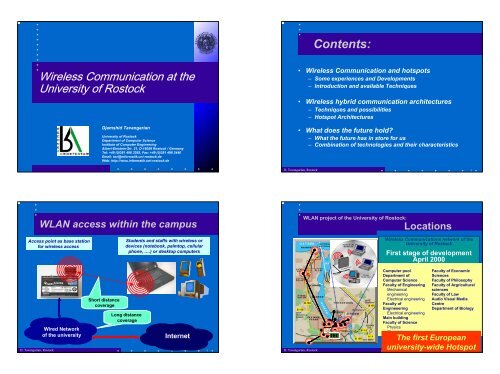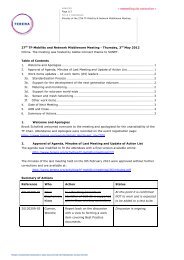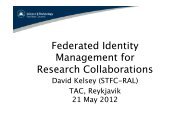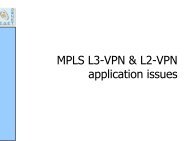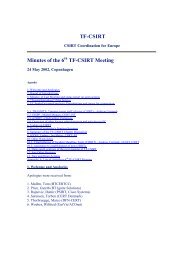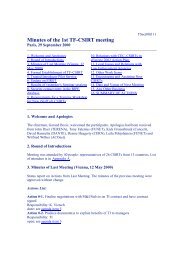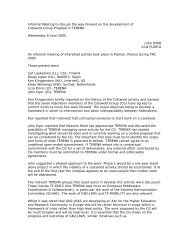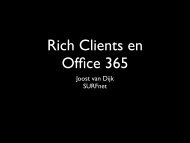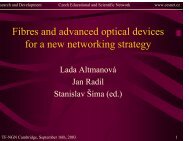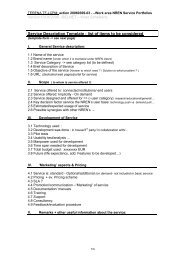Wireless LAN an der Universität Rostock - Terena
Wireless LAN an der Universität Rostock - Terena
Wireless LAN an der Universität Rostock - Terena
You also want an ePaper? Increase the reach of your titles
YUMPU automatically turns print PDFs into web optimized ePapers that Google loves.
D. Tav<strong>an</strong>gari<strong>an</strong>, <strong>Rostock</strong><br />
<strong>Wireless</strong> Communication at the<br />
University of <strong>Rostock</strong><br />
Djamshid Tav<strong>an</strong>gari<strong>an</strong><br />
University of <strong>Rostock</strong><br />
Department of Computer Science<br />
Institute of Computer Engineering<br />
Albert-Einstein-Str. 21, D-18059 <strong>Rostock</strong> / Germ<strong>an</strong>y<br />
Tel: +49 (0)381 498 3385, Fax: +49 (0)381 498 3440<br />
Email: tav@informatik.uni-rostock.de<br />
Web: http://wiss.informatik.uni-rostock.de<br />
W<strong>LAN</strong> access within the campus<br />
Access point as base station<br />
for wireless access<br />
Short dist<strong>an</strong>ce<br />
coverage<br />
Students <strong>an</strong>d staffs with wireless or<br />
devices (notebook, palmtop, cellular<br />
phone, ….) or desktop computers<br />
Long dist<strong>an</strong>ce<br />
coverage<br />
Wired Network<br />
of the university Internet<br />
3<br />
D. Tav<strong>an</strong>gari<strong>an</strong>, <strong>Rostock</strong><br />
Contents:<br />
• <strong>Wireless</strong> Communication <strong>an</strong>d hotspots<br />
– Some experiences <strong>an</strong>d Developments<br />
– Introduction <strong>an</strong>d available Techniques<br />
• <strong>Wireless</strong> hybrid communication architectures<br />
– Techniques <strong>an</strong>d possibilities<br />
– Hotspot Architectures<br />
• What does the future hold?<br />
– What the future has in store for us<br />
– Combination of technologies <strong>an</strong>d their characteristics<br />
D. Tav<strong>an</strong>gari<strong>an</strong>, <strong>Rostock</strong><br />
W<strong>LAN</strong> project of the University of <strong>Rostock</strong>:<br />
Locations<br />
<strong>Wireless</strong> Communications network of the<br />
• 8 Building University areas of (approx. <strong>Rostock</strong> 350<br />
buildings)<br />
First stage of development<br />
• Distributed over the whole city<br />
April 2000<br />
• Hystorical buildings<br />
Computer pool<br />
Faculty of Economic<br />
•Department Primary of part: Sciences<br />
Computer – Fiber Science optic backboone Faculty of star Philosophy topology<br />
Faculty – About of Engineering 70 km fiber Faculty optics of Argricultural (20 / 28<br />
Mech<strong>an</strong>ical Fasern) sciences<br />
engineering<br />
Faculty of Law<br />
Electrical – ATM engineering with 155 Mbps Audio <strong>an</strong>d Visual Gigabit- Media<br />
Faculty Ethernet of<br />
Centre<br />
•Engineeering Secondary part: Department of Biology<br />
Electrical engineering<br />
– Fiber optics within the building<br />
Main building<br />
complexes<br />
Faculty of Science<br />
Physics – ATM with 155 Mbps or Gigabit-<br />
Chemistry Ethernet<br />
The first Europe<strong>an</strong><br />
university-wide Hotspot<br />
2<br />
4
D. Tav<strong>an</strong>gari<strong>an</strong>, <strong>Rostock</strong><br />
D. Tav<strong>an</strong>gari<strong>an</strong>, <strong>Rostock</strong><br />
Hotspot at the University of <strong>Rostock</strong> / Germ<strong>an</strong>y<br />
The Next Steps:<br />
Notebook phone within the W<strong>LAN</strong>-hotspot<br />
Phone<br />
1<br />
.<br />
.<br />
.<br />
Phone<br />
n<br />
HICOM<br />
Phone<br />
system<br />
of the<br />
university<br />
Gateway<br />
1<br />
Gateway<br />
2<br />
Features of the mobile hotspot phone system:<br />
• calls from student to student,<br />
• calls to the teachers or university staff<br />
• to receive calls from within as well as from the<br />
outside of the university<br />
University<br />
Network<br />
(wired<br />
<strong>an</strong>d<br />
wireless)<br />
Notebook<br />
Headset<br />
.<br />
.<br />
5<br />
Desktops<br />
7<br />
D. Tav<strong>an</strong>gari<strong>an</strong>, <strong>Rostock</strong><br />
Our experiences<br />
• W<strong>LAN</strong> is available since April 2000<br />
• More th<strong>an</strong> 200 Access Points are installed<br />
• About 1000 users, approx. 3000 hour daily access<br />
• Secure communication network with VPN <strong>an</strong>d IPSec<br />
• Mobility of the users within the whole university<br />
• Access to internet from<br />
– lecture, meeting <strong>an</strong>d working rooms, Labs etc.,<br />
– dormitories,<br />
– student restaur<strong>an</strong>ts <strong>an</strong>d cafes,<br />
– libraries,<br />
– neighbourhood of the university, etc.<br />
• Spont<strong>an</strong>eous networks by student groups<br />
D. Tav<strong>an</strong>gari<strong>an</strong>, <strong>Rostock</strong><br />
The next Steps:<br />
Roaming between the Germ<strong>an</strong> Universities<br />
• University of Aachen<br />
• Universities in Berlin<br />
• University of Bremen<br />
• University of Erl<strong>an</strong>gen<br />
• Techn. University of Darmstadt<br />
• Techn. University of Dresden<br />
• University of Fr<strong>an</strong>kfurt<br />
• University of Feiburg<br />
• University of Hamburg<br />
• University of Karlsruhe<br />
• University of Luebeck<br />
• University of M<strong>an</strong>nheim<br />
• Universities in Munich<br />
• University of Pa<strong>der</strong>born<br />
• University of <strong>Rostock</strong><br />
• University of Saarbruecken<br />
• University of Wuerzburg<br />
Hamburg<br />
Bremen<br />
Luebek<br />
Dortmund<br />
H<strong>an</strong>nover<br />
Aachen<br />
Pa<strong>der</strong>born<br />
Karlsruhe<br />
<strong>Rostock</strong><br />
Munich<br />
Berlin<br />
Fr<strong>an</strong>kfurt<br />
Dresden<br />
M<strong>an</strong>nheim<br />
Erl<strong>an</strong>gen<br />
Darmstadt<br />
Saarbrücken<br />
Freiburg<br />
6<br />
8
D. Tav<strong>an</strong>gari<strong>an</strong>, <strong>Rostock</strong><br />
Conclusion<br />
W<strong>LAN</strong> communication in Germ<strong>an</strong> universities<br />
• We were the first university in Europe <strong>an</strong>d world-wide<br />
one of the three universities with a univerity-wide<br />
W<strong>LAN</strong>.<br />
• Country wide support of 45 universities on behalf of the<br />
Germ<strong>an</strong> Ministry of Research & Education (10 Mio. DM)<br />
• Start of the reseach program for the realization of<br />
„Notebook-Universities“ in Germ<strong>an</strong>y (50 Mio. DM)<br />
Our Goal:<br />
Use of W<strong>LAN</strong> hotspots for <strong>an</strong> ubiquitous University!<br />
D. Tav<strong>an</strong>gari<strong>an</strong>, <strong>Rostock</strong><br />
One of our research fields<br />
<strong>Wireless</strong> communication (wireless <strong>LAN</strong>)<br />
• Infrastructure (W<strong>LAN</strong> public <strong>an</strong>d private hotspots) of the<br />
wireless communication with W<strong>LAN</strong> systems regarding<br />
to the IEEE st<strong>an</strong>dard 802.11b, a, h, g, i, x …<br />
• Research <strong>an</strong>d development fields:<br />
– The efficiency of a communication infrastructure<br />
– Safety <strong>an</strong>d security aspects in local <strong>an</strong>d in wide area<br />
communication networks<br />
– Multicast <strong>an</strong>d broadcast communication<br />
– Hybrid Communication<br />
– Voice-over-IP (VoIP)<br />
– etc.<br />
9<br />
11<br />
D. Tav<strong>an</strong>gari<strong>an</strong>, <strong>Rostock</strong><br />
Dist<strong>an</strong>ce<br />
500-1000 km<br />
D. Tav<strong>an</strong>gari<strong>an</strong>, <strong>Rostock</strong><br />
Research<br />
<strong>an</strong>d<br />
Developments<br />
Hybrid Communication with<br />
<strong>Wireless</strong> Communication Techniques<br />
10-50 km<br />
1-6 km<br />
20-500 m<br />
5-15 m<br />
1-1,5 m<br />
GSM<br />
TETRA- Systems<br />
DECT<br />
GPRS<br />
IRDA<br />
EDGE<br />
EGPRS<br />
Satellite tr<strong>an</strong>smission<br />
UMTS<br />
Power Bluetooth<br />
Bluetooth<br />
Kbit r<strong>an</strong>ge Mbit r<strong>an</strong>ge<br />
W<strong>LAN</strong>/802.11b<br />
Wide-Area / Low BW Local-Area / High BW<br />
HYBRID COMMUNICATION<br />
Hiper<strong>LAN</strong>/2<br />
W<strong>LAN</strong>/802.11a<br />
10<br />
B<strong>an</strong>dwidth<br />
12
D. Tav<strong>an</strong>gari<strong>an</strong>, <strong>Rostock</strong><br />
Mobile Communication Techniques (I)<br />
• GSM (Global System for Mobile<br />
Communications)<br />
worldwide mobile communication st<strong>an</strong>dard,<br />
9600 (14.400) Bit/s,<br />
basic "framework" for m<strong>an</strong>y extensions<br />
– GSM Radio Modems (PC Card)<br />
– cellular phone <strong>an</strong>d interface to notebook<br />
or h<strong>an</strong>dheld computer<br />
D. Tav<strong>an</strong>gari<strong>an</strong>, <strong>Rostock</strong><br />
Mobile Communication Techniques (II)<br />
• GPRS (General Packet Radio Service)<br />
GSM extension: packet oriented tr<strong>an</strong>smission<br />
with all 8 slots (bundled) of a GSM<br />
connection, max. 170 kBit/s, accounting<br />
based on tr<strong>an</strong>smitted data volume<br />
– requires new hardware on both sides, the<br />
operator's <strong>an</strong>d the user's<br />
– already available<br />
13<br />
15<br />
D. Tav<strong>an</strong>gari<strong>an</strong>, <strong>Rostock</strong><br />
Architecture of a GSM-Network<br />
Base Station Subsystem<br />
• BSC Base Station Controller<br />
• BTS Base Tr<strong>an</strong>sceiver Station<br />
• VLR Visitor Location Register<br />
• HLR Home Location Register<br />
• (G)MSC (Gateway) Mobile Switching Centre<br />
• EIR Equipment Identity Register<br />
• PSTN Public Switched Telephone Network<br />
• ISP Internet Service Provi<strong>der</strong><br />
D. Tav<strong>an</strong>gari<strong>an</strong>, <strong>Rostock</strong><br />
: Radio Subsystem<br />
GPRS Architecture<br />
Mobile Station<br />
Base Station Subsystem<br />
BTS<br />
BSS<br />
RSS<br />
Radio Subsystem<br />
BSC<br />
• BSC Base Station Controller<br />
• BTS Base Tr<strong>an</strong>sceiver Station<br />
• VLR Visitor Location Register<br />
• HLR Home Location Register<br />
• (G)MSC (Gateway) Mobile Switching Centre<br />
• SGSN Serving GPRS Support Node<br />
• GGSN Gateway GPRS Support Node<br />
VLR<br />
SGSN<br />
Backbone<br />
MSC<br />
HLR<br />
NSS<br />
Network & Switching<br />
Subsystem<br />
Operation Subsystem<br />
Network & Switching<br />
Subsystem<br />
14<br />
GGSN Internet<br />
16
D. Tav<strong>an</strong>gari<strong>an</strong>, <strong>Rostock</strong><br />
D. Tav<strong>an</strong>gari<strong>an</strong>, <strong>Rostock</strong><br />
Mobile Communication Techniques (III)<br />
• UMTS / W-CDMA<br />
(Universal Mobile Telecommunications System /<br />
Wideb<strong>an</strong>d-CDMA)<br />
new mobile communication network with packet oriented<br />
tr<strong>an</strong>smission, accounting based on tr<strong>an</strong>smitted data volume<br />
– 3 modes:<br />
• 2MBit/s (stationary),<br />
• 512 kBit/s (< 60 km/h),<br />
• 128 kBit/s (> 60 km/h)<br />
– use of IP (from radio reception down to the Backbone)<br />
– "Voice over IP"<br />
– requires new hardware on both sides, the operator's <strong>an</strong>d the<br />
user's (2-3 times higher density of tr<strong>an</strong>smitters in comparison<br />
to GSM)<br />
– frequencies: 1,9 - 2,2 GHz<br />
– probably available in 2003<br />
Radio <strong>LAN</strong>s (II)<br />
• Hiper<strong>LAN</strong>/2<br />
– frequency: 5,2 <strong>an</strong>d 5,6 GHz<br />
– with ch<strong>an</strong>nel bundling up to 54 Mbit/s (Hiper<strong>LAN</strong>/2)<br />
– originally developed on the basis of wireless ATM<br />
research<br />
– st<strong>an</strong>dardization not yet finished<br />
– supports QoS (Quality of Service)<br />
– DES encryption<br />
– includes authentification mech<strong>an</strong>ism<br />
– capable of multicasts<br />
17<br />
19<br />
D. Tav<strong>an</strong>gari<strong>an</strong>, <strong>Rostock</strong><br />
UMTS-Architecture<br />
Hierarchical Structure of UMTS Radio-<strong>LAN</strong><br />
Data rates:<br />
Macro-Level:<br />
Up to 144 kBit/s<br />
Speed max. 500 km/h<br />
Micro-Level:<br />
Up to 384 kBit/s<br />
Speed max. 120 km/h<br />
Piko-Level:<br />
Up to 2 MBit/s<br />
Speed max. 10 km/h<br />
MAC-<br />
Layer<br />
PHY-<br />
Layer<br />
D. Tav<strong>an</strong>gari<strong>an</strong>, <strong>Rostock</strong><br />
Mikrozelle<br />
Pikozelle<br />
W<strong>LAN</strong>-st<strong>an</strong>dards<br />
802.11h<br />
Power Tr<strong>an</strong>smit<br />
Control<br />
802.11a<br />
5 GHz<br />
54 Mbit/s<br />
Makrozelle<br />
Satellitensystem<br />
Integration mit dem Festnetz<br />
802.11f: Inter Access Point Protocol<br />
802.11e: QoS Enh<strong>an</strong>cement<br />
802.11i: Security Enh<strong>an</strong>cement<br />
IEEE 802.11<br />
802.11g<br />
2,4 GHz<br />
>20Mbit/s<br />
802.11b<br />
2,4 GHz<br />
11 Mbit/s<br />
Current subjects of St<strong>an</strong>dardisation<br />
802.11<br />
2,4 GHz<br />
2 Mbit/s<br />
18<br />
20
D. Tav<strong>an</strong>gari<strong>an</strong>, <strong>Rostock</strong><br />
Airport<br />
D. Tav<strong>an</strong>gari<strong>an</strong>, <strong>Rostock</strong><br />
Architecture of <strong>an</strong> Ubiquitous W<strong>LAN</strong> Hotspot<br />
Notebook University of <strong>Rostock</strong><br />
<strong>Wireless</strong> / Local<br />
Wired / Local<br />
Railway<br />
Station<br />
Public<br />
W<strong>LAN</strong><br />
Campus<br />
AP<br />
AP<br />
Switches<br />
Switches<br />
Firewale<br />
Firewale<br />
Office<br />
Central Equipments<br />
Semi-public<br />
W<strong>LAN</strong><br />
Server-Pool<br />
ELDAB<br />
Securityserver<br />
ASP<br />
Fileserver<br />
Nameserver<br />
Computeserver<br />
Gatekeeper<br />
Unified Messaging<br />
…<br />
The W<strong>LAN</strong> Hotspots<br />
as killer alternatives…?<br />
Mobile<br />
Mobile<br />
Vehicles<br />
Vehicles<br />
Hospital<br />
Congress hall,<br />
Hotel<br />
Firewale<br />
Switches<br />
Corporate<br />
W<strong>LAN</strong><br />
Office<br />
Home<br />
W<strong>LAN</strong><br />
Internet<br />
Pl<strong>an</strong>t<br />
Remote<br />
Access<br />
21<br />
23<br />
D. Tav<strong>an</strong>gari<strong>an</strong>, <strong>Rostock</strong><br />
wide-r<strong>an</strong>ge<br />
short-r<strong>an</strong>ge<br />
Kind of W<strong>LAN</strong> Hotspots<br />
• Public Hotspots (billing needed)<br />
– Open Community (Conferences, Hotels, …)<br />
– Selected Users (Airport, Pre-paid, subscribers, tickets<br />
….)<br />
• Private Hotspots (no billing needed)<br />
– Closed Communities (Universities, Enterprise,<br />
Hospitals, Comp<strong>an</strong>ies, …)<br />
D. Tav<strong>an</strong>gari<strong>an</strong>, <strong>Rostock</strong><br />
Frequency<br />
[GHz]<br />
Data Rate Tr<strong>an</strong>smission<br />
Power [W]<br />
Encryption St<strong>an</strong>dard Connection<br />
Fees<br />
GSM 0.9/ 1.8 (1.9) 9.6kBit/s 1-2 - different yes ok<br />
(14.4kBit/s)<br />
frequencies<br />
HSCSD (GSM) 43.2 kBit/s (GSM) - yes yes ok<br />
GPRS (GSM) 170 kBit/s (GSM) ? yes yes 2000<br />
EDGE (GSM) 384 kBit/s (GSM) ? yes yes 2001<br />
UMTS/<br />
W-CDMA<br />
<strong>Wireless</strong> Communication<br />
Technologies<br />
1.9 ... 2.17 128 kBit/s<br />
...<br />
2 Mbit/s<br />
1-2 yes yes yes 2003<br />
TETRA 28.8 kBit/s 1-30 yes ETSI no ok<br />
22<br />
Availability<br />
Bluetooth 2.402 - 2.480 1-2MBit/s 0.001<br />
(0.1)<br />
yes no ok<br />
HomeRF 2.4 (FHSS) 1-2Mbit/s 0.1 yes yes no 2001<br />
W<strong>LAN</strong> 2.412 - 2.472 1-11 Mbit/s 0.05- WEP IEEE<br />
no ok<br />
(DSSS)<br />
0.1 40/128 Bit 802.11(b)<br />
Hiper<strong>LAN</strong>2 5.2 / 5.6 24 Mbit/s ≈0.1 yes ETSI no 2001 / 2002<br />
24
D. Tav<strong>an</strong>gari<strong>an</strong>, <strong>Rostock</strong><br />
Combination of <strong>Wireless</strong> systems<br />
for a Hybrid Communication<br />
Wide-area communication<br />
• Mobile phone systems<br />
– GSM<br />
– GPRS,<br />
– HSCSD,<br />
– UMTS<br />
– W-CDMA<br />
– . . .<br />
D. Tav<strong>an</strong>gari<strong>an</strong>, <strong>Rostock</strong><br />
Seemless Hybrid Roaming<br />
Mobile Client<br />
SAP/Metaphase<br />
Server<br />
Access Point<br />
WWW-Server<br />
W<strong>LAN</strong>-<br />
Hotspot<br />
Intr<strong>an</strong>et<br />
WWW-Server<br />
Firewall<br />
Tr<strong>an</strong>smitter<br />
Local-area communication<br />
• <strong>Wireless</strong> Technics (Radio<br />
<strong>LAN</strong>s)<br />
– W<strong>LAN</strong><br />
– Bluetooth<br />
– HomeRF<br />
– Hiper<strong>LAN</strong>/2<br />
– . . .<br />
GSM/GPRS or UMTS<br />
ISDN, ATM,<br />
Wired-Network<br />
Wired-NW<br />
ISDN, ATM,<br />
Wired-Network<br />
Internet<br />
Phone<br />
Network<br />
Wired-NW<br />
Wired-NW<br />
ISP<br />
25<br />
27<br />
D. Tav<strong>an</strong>gari<strong>an</strong>, <strong>Rostock</strong><br />
Mobile Client in a GSM, GPRS or UMTS Network<br />
Mobile Client<br />
SAP/Metaphase<br />
Server<br />
D. Tav<strong>an</strong>gari<strong>an</strong>, <strong>Rostock</strong><br />
Intr<strong>an</strong>et<br />
WWW-Server<br />
Firewall<br />
Tr<strong>an</strong>smitter<br />
GSM/GPRS or UMTS<br />
Wired-NW<br />
ISDN, ATM,<br />
Wired-Network<br />
Internet<br />
Phone<br />
Network<br />
Wired-NW<br />
Wired-NW<br />
ISP<br />
Interco-operation in a Hybrid Mobile Network<br />
Conceptions:<br />
Loose Coupling:<br />
Only Authentication, Authorization <strong>an</strong>d Accounting of<br />
W<strong>LAN</strong> access is performed by the mobile network<br />
operator.<br />
Tight Coupling:<br />
W<strong>LAN</strong> as just <strong>an</strong>other radio access technology with<br />
all necessary conditions (security, billing, AAA …)<br />
given by the same mobile operator.<br />
26<br />
28
D. Tav<strong>an</strong>gari<strong>an</strong>, <strong>Rostock</strong><br />
D. Tav<strong>an</strong>gari<strong>an</strong>, <strong>Rostock</strong><br />
Realization of the Hybrid Roaming<br />
Method of Socket-Tunneling<br />
Seemless Roaming <strong>an</strong>d H<strong>an</strong>dover Unit for<br />
W<strong>LAN</strong>/GPRS, W<strong>LAN</strong>/UMTS<br />
PCMCIA<br />
for W<strong>LAN</strong><br />
access<br />
Mobile phone<br />
for wide-area<br />
access<br />
Hotspot area<br />
Long-dist<strong>an</strong>ce<br />
traffic area<br />
Link<br />
to the<br />
Comp.<br />
Cellphone<br />
W<strong>LAN</strong><br />
Level<br />
Processor<br />
unit <strong>an</strong>d<br />
switches<br />
GSM<br />
GPRS<br />
Level<br />
29<br />
Control<br />
unit<br />
31<br />
D. Tav<strong>an</strong>gari<strong>an</strong>, <strong>Rostock</strong><br />
D. Tav<strong>an</strong>gari<strong>an</strong>, <strong>Rostock</strong><br />
Hybrid-Roaming Components<br />
Our Current <strong>an</strong>d future Projects<br />
• Notebook-University<br />
• Hybrid Communication systems for W<strong>LAN</strong>-UMTS<br />
• Hybrid cellphone system<br />
• Our Proposal for the 6 th FP Call of EU entitled<br />
“Complete electronic traceability of food chains” within<br />
“Food Quality <strong>an</strong>d Safty”<br />
• Our Projects<br />
– TOPAS:<br />
Complete traceability of cool food chains:<br />
Temperature measurement, Object identification, Positioning, Archiving, Security of<br />
Cool <strong>an</strong>d frozen Chains from producer to consumer<br />
Particip<strong>an</strong>ts: Germ<strong>an</strong>y, Spain, Fr<strong>an</strong>ce, Norway (GSM/SMS, UMTS,<br />
W<strong>LAN</strong>)<br />
– Local_Web:<br />
<strong>Wireless</strong> Portal for Local-based services like entertainement (movie,<br />
video, games, …), education (l<strong>an</strong>guages, dictionaries,…), local services<br />
(restaur<strong>an</strong>ts, cinema, disco, …), …<br />
Particip<strong>an</strong>ts: Icel<strong>an</strong>d, Holl<strong>an</strong>d, Germ<strong>an</strong>y, Greece (W<strong>LAN</strong> / UMTS)<br />
30<br />
32
D. Tav<strong>an</strong>gari<strong>an</strong>, <strong>Rostock</strong><br />
Applications<br />
• Mobile Robots in industrial environment<br />
– Secur communication for robot control<br />
(better safe th<strong>an</strong> sorry!)<br />
– Normal communication: W<strong>LAN</strong> in<br />
enterprise hotspots<br />
– If necessary: GSM communication<br />
– Spont<strong>an</strong>eous networks<br />
D. Tav<strong>an</strong>gari<strong>an</strong>, <strong>Rostock</strong><br />
Applications<br />
eService Architecture<br />
1<br />
Producer<br />
of<br />
Cool Ware<br />
Conception of Complete traceability of cool food chains<br />
2 Truck<br />
Truck<br />
Wholesale<br />
Trade<br />
3 5<br />
Retail<br />
Trade<br />
Farmer Internet<br />
Consumer<br />
Mobile or Fix network<br />
Control <strong>an</strong>d Service-<br />
Center/Provi<strong>der</strong><br />
Storage of Data, Alarm-M<strong>an</strong>agement, etc.<br />
4<br />
Call<br />
Center<br />
33<br />
35<br />
Hybrid-<br />
Cellphone<br />
D. Tav<strong>an</strong>gari<strong>an</strong>, <strong>Rostock</strong><br />
D. Tav<strong>an</strong>gari<strong>an</strong>, <strong>Rostock</strong><br />
Applications<br />
W<strong>LAN</strong>-GSM Cellphone<br />
Hotspot<br />
Call-Server<br />
AP AP AP<br />
Mobilephone<br />
UMTS<br />
GSM<br />
Security<br />
Further<br />
Developments<br />
Gateway<br />
PSTN<br />
Internet<br />
34<br />
36
D. Tav<strong>an</strong>gari<strong>an</strong>, <strong>Rostock</strong><br />
Facts <strong>an</strong>d Trends<br />
• Current developments:<br />
– More Internet connections<br />
– High perform<strong>an</strong>ce PDAs <strong>an</strong>d Notebooks<br />
– More mobility<br />
– New „<strong>Wireless</strong> Informations Devices“<br />
e.g. SmartPhones: bigger displays, Cameras, GPS, ...<br />
– A high number of processors in embedded-systems<br />
• Fact: Cheap <strong>an</strong>d small electronic devices,<br />
therefore, more <strong>an</strong>d more mobile (networked!)<br />
devices!<br />
• Trends <strong>an</strong>d Challenges: Spont<strong>an</strong>eous networking,<br />
new communication architectures, utillisation of<br />
spont<strong>an</strong>eous services, Ubiquitous networks, etc.<br />
Challenges<br />
Spont<strong>an</strong>eous networking<br />
Addressing method of packing materials in a truck<br />
Truck A<br />
Truck B<br />
D. Tav<strong>an</strong>gari<strong>an</strong>, <strong>Rostock</strong><br />
…<br />
Truck P<br />
Addresspattern: 64 bit<br />
4 bit<br />
Kateg.<br />
Cont. A a<br />
Cont. A b<br />
20 bit<br />
Firmen<br />
…<br />
Cont. A q<br />
16 bit<br />
LKW<br />
Palett A a1<br />
Palett A a2<br />
…<br />
Palett A <strong>an</strong><br />
8 bit<br />
Container<br />
8 bit<br />
Paletts<br />
8 bit<br />
Kisten<br />
Box A a11<br />
Box A a12<br />
37<br />
…<br />
Box A a1n<br />
39<br />
D. Tav<strong>an</strong>gari<strong>an</strong>, <strong>Rostock</strong><br />
Challenges<br />
Spont<strong>an</strong>eous Networks<br />
• Independent spont<strong>an</strong>eous<br />
networks in geographic<br />
defined area<br />
– position determination<br />
– Multi hop routing<br />
– Availability or services in a<br />
defined area<br />
• Example:<br />
Cars of a producer (e. g.<br />
BMW or VW) realize <strong>an</strong>d<br />
org<strong>an</strong>ize their own<br />
spont<strong>an</strong>eous communication<br />
networks.<br />
D. Tav<strong>an</strong>gari<strong>an</strong>, <strong>Rostock</strong><br />
Router<br />
Router<br />
Router<br />
Contact address Th<strong>an</strong>k you for<br />
your attention!<br />
Prof. Dr.-Ing. habil.<br />
Djamshid Tav<strong>an</strong>gari<strong>an</strong><br />
University of <strong>Rostock</strong><br />
Department of Computer Scienece<br />
Institute of Computer Engineering<br />
Albert-Einstein-Str. 21, D-18059 <strong>Rostock</strong> / Germ<strong>an</strong>y<br />
Phone: +49 (0)381 498-3386 (Tav<strong>an</strong>gari<strong>an</strong>), -2360 (Burchert)<br />
Fax: +49 (0)381 498-3440<br />
E-Mail: tav@informatik.uni-rostock.de<br />
Web: http://wl<strong>an</strong>.informatik.uni-rostock.de<br />
38<br />
40


